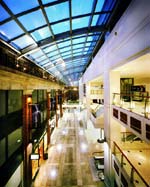
Home About Us Contact Us Subscribe

Home About Us Contact Us Subscribe
|
|
|
|
Pioneering Forum Stimulates Urban Regeneration Debate
Leeds, UK: A British architect's vision to enhance the quality of projects that impact on our everyday lives brings together key players who shape cities and towns throughout Yorkshire. by ArchNewsNow August 12, 2002 Editor’s note: Links to firms, agencies, and projects
mentioned are included at the end of the article. In January 2001,
Ian Tod of Allen Tod Architecture, aware that much of the quality work being
done in the region was largely invisible and unknown, set out to widen the
debate on creating quality places in which people live, work, and play.
Supported by RIBA Yorkshire, he invited 16 regional architectural practices to
share a common platform in the “4x4 2001: Making Our Cities” initiative that
comprised a series of four presentations over four weeks at Leeds Metropolitan
University School of Architecture. “4x4 started as a response to various comments that Leeds (and
other places in the region) needed major projects from outside architects if it
was to achieve its aspirations as a European city,” Ian Tod recalls. “When
discussing this, we had to recognize that the design strengths of the region
were hidden, partly because of a London emphasis in the media – but also
because we, ourselves, were not doing anything about it. “The first year was therefore concentrated on removing the covers
and finding out what was going on, mainly in Leeds,” Tod explains. “This led to
a series of follow up meetings that are pursuing, amongst other things, design
competitions and a study tour.” Objectives and Issues
According to Tod, 4x4 is about stimulating informed debate. It
provides an opportunity for people to hear the views of the designers,
engineers, developers, politicians, and public servants who are actively engaged
in delivering change and improvements in towns and cities. It is an open (and free) forum. It intends to avoid being what Tod
calls “coconut shy,” where speakers are there to be attacked by members of the
public, but does choose topics that can be controversial. “Making good places
requires the co-operation of numerous agencies, much creative skill from many
people, and lots of persistence,” Tod says. The series provides
insights into the development process that is little understood in public debate
– which tends to concentrate on the promises, the problems, and then, briefly,
the results. 4x4 hopes to open up the process – the different players involved
in delivering regeneration openly discuss the driving ideas and principles, and
the problems and solutions encountered. “In September 2001, a group of 4x4 participants went to the
European Building Exhibition in Malmö, Sweden. It was agreed that a debate that spread across the
professions and roles would be even more valuable,” says Tod. The 2002 4x4 Making Our Cities event certainly did stimulate
debate. The four sessions, held over four weeks in February and March, included
politicians, architects, traffic engineers, a community artist, public
servants, a museum director, developers, master planners, and journalists. Most
importantly, at each event, about 200 community members (the public!) turned
out for – and contributed to – the debates. The issues raised included: the nature of residential development
in city centers; the current dominance of a selected list of bars and cafes;
the lack of medical facilities; the importance of quality in buildings and
public areas; whether a single architectural vision can deliver variety in a
major scheme; how art and public places can be brought into infrastructure and
transport schemes; the role of public agencies and public and private finance;
and the ability of the private sector to deliver good public spaces. The 2002 Presentations
City Visions: The Vision Thing
The first
session, on February 28, looked at the value and necessity of urban
visions and ambitions, with input from designers, administrators, politicians,
and senior representatives from the development agency Yorkshire Forward whose
Urban Renaissance Programme is taking on the challenge to rejuvenate a group of
towns in the region. Former head of Sheffield Development Agency, Colin Farmer,
explained the thinking behind the “Heart of Sheffield” project which has
involved the demolition of the 1970’s Town Hall as well as the construction of Peace
Gardens, Millennium Gallery, and Winter Garden in a plan designed to tie back
together a city that had become fragmented. He also highlighted issues of
delivery, teamwork, and persistence. Councillor Liz Minkin of Leeds explained the process behind the “Vision for Leeds,” and explained
how the Leeds Initiative was structured to deliver results. Minkin emphasized
the importance of the public realm to the city. Alan Simpson, Yorkshire
Forward’s Director of Regeneration, and Helen Farrar, Urban Renaissance
Manager, explained how the Renaissance
Towns Initiative works with a
panel of consultants drawn from the UK, the US, and Europe. As a hot local
issue, this has stimulated ongoing debate. Jon Rouse, Chief Executive of CABE,
chaired the session. Landmarks and Quarters Kevin Grady, Director of the Leeds Civic Trust, chaired the second
session. He started by covering some of the larger challenges and projects in
the region including the Holbeck Urban Village in Leeds that has been a long
time in gestation. The first major scheme is now on site at the Round Foundry and the
developer, Roland Stross of St. James Securities, explained how the mix had
been achieved with current market demands and grant finance. Architect Ken Moth
of BDP explained the design that is a mix of restoration and new buildings
around a set of courtyards. On a site nearby, planning consent has recently been obtained for
Bridgewater Place, which, at 32 stories, will be the tallest building in Leeds
and will occupy a gateway site to the city. Dominic Boyes of Abbey Holford Rowe
(now Aedas AHR) presented this proposal. At the other end of the city center is the Clarence Dock
development alongside The Royal Armouries Museum. Gordon Carey of Carey Jones
Architects outlined future plans. In
contrast to the above – in building type and economic context, if not in scale
– Bill Maynard of Urban Splash set out their proposals for Lister’s Mill
(or Manningham Mills) in Bradford. This is a massive undertaking, not only in
terms of adaptive re-use and building, but also in achieving economic critical
mass to make it work as a development with a sufficient mix of activity to make
it work as a place. (This sparked another lively debate.) Leisure vs. Culture
Martin Wainwright, Northern Editor of The Guardian newspaper,
chaired the third program. The session partly set the strong commercial leisure
sector against the more traditional culture of museums, theater, and the like. Julian Monaghan of DLG Architects explained the commercial and
design thinking behind major leisure schemes such as The Light and Xscape,
showing how quality of place and a workable public domain can be created within
them. David Bye of Brewster Bye explained the proposals developed by Yorkshire
Design Developments and West Yorkshire Playhouse. This will provide resources
for the Playhouse as well as new residential and commercial uses on Quarry
Hill. Stephen Feber, Chief Executive at Magna Science Adventure
Centre, showed how a creative cultural project can be an attraction, a tool
for regeneration, and also a growth point for education into the future,
setting the debate in a new framework. Leeds Civic Architect, John Thorp, explained the proposals for the
City of Leeds Museum and the complex chess game required to achieve it. The
Museum will be sited in the
Leeds Institute, another ambitious 19th century building by Cuthbert Brodrick
who designed the Town Hall and the Corn Exchange. This now overlooks the new
Millennium Square and ties into other projects such as a new theater and a
museum resource center in Hunslet. Getting There: Transport, Movement, and Place
Under the chairmanship of Robert Powell of Public Arts, the fourth
and final session covered the issue of transport. Andrew Hall of Leeds City
Council set out the key points of the transport strategy for the city and the
growing emphasis on public transportation. In contrast, Adrian Sinclair concentrated on the local scale with
the story of the Home Zones created in the Methleys over a few streets in
Harehills. Irena Bauman, of Bauman Lyons Architects, explained the partnership
and process behind the lively and iconic set of bus stops in Manchester Road,
Bradford, that serve the new guided bus. Finally, Adrian Pope outlined the
state of play with Leeds Supertram, where the process is now well underway with
a selected list invited to bid. The Way Forward
“Making good places needs common objectives and lively
discussion,” Ian Tod declares. “These are required to underpin partnerships
where wide-ranging organizations bring together the creative skills of the
region. Powerful partnerships will enable us to not only sustain the vision for
Leeds as a dynamic cosmopolitan capital – but to also realize the visions of
the diverse towns and cities throughout the county.” All the participants shared Tod’s enthusiasm for the 4x4 program.
“It has brought together, for the first time, a range of professionals who
should, but rarely do, engage in debate about built environment in this region.
There is a hunger for such a forum,” said Irena
Bauman, Bauman Lyons. “There is now a glimmer of hope that we may
develop a cluster of highly engaged and inquisitive professionals who will
campaign for a better quality of the built environment.” Gordon Carey, Carey Jones Architects,
said: “I believe that we should continue with these
lectures/debates over the next few years to improve the public
perception/understanding that the contribution of good urban design and
architecture can make to our environment.” The forum is accelerating from strength to strength
and backed by supporting partners including English Heritage, RIBA Yorkshire,
and the regional development agency Yorkshire Forward. A third 4x4
series is currently being planned for March 2003 at the Leeds Metropolitan
University School of Architecture. In line with the theme of raising the level of
debate on creating quality towns and cities, Ian Tod is coordinating a visit to
this year’s Biennale di
Venezia 8th International Architecture Exhibition, “NEXT: the future of
world architecture.” The exhibition will showcase key projects that will
shape the face of the built environment over the next decade. The event is
taking place from September 8 - November 3, and the 4x4 group will be attending
from October 24-28. An invitation is extended to interested parties. For more
information, e-mail Jill Callighan at Allen Tod Architecture: jc@allentod.co.uk or call her at + 44 113 244
9973. The 2002 4x4 Participants The Vision Thing: - New Heart for
Sheffield – Colin Farmer, former head of Sheffield Development Agency - Vision for Leeds – Councillor
Elizabeth Minkin, Leeds City Council - The Yorkshire Renaissance Towns
Programme – Alan
Simpson, Director of Regeneration, Yorkshire Forward
and Helen Farrar, Urban Renaissance Manager, Yorkshire Forward - Chair – John Rouse, CABE Landmarks and Quarters: -Holbeck Urban Village, Round Foundry –
Roland Stross, St. James Securities and Ken Moth, BDP/Building Design Partnership - New Tower at Bridgewater Place, Leeds –
Ken Morton/Ian Barraclough, Landmark Developments, and Dominic Boyes, Abbey Holford Rowe (now Aedas AHR) - Clarence Dock – Gordon
Carey, Carey Jones Architects with
Berkeley Group - Manningham Mills – Bill Maynard, Urban Splash - Chair – Heather Hancock, Yorkshire
Forward Leisure vs. Culture: - Big Leisure Projects, The Light and
Xscape – Julian Monaghan, DLG
Architects - Partnering with West Yorkshire
Playhouse – David Bye, Brewster
Bye Architects - Magna Science Adventure Centre – Stephen Feber, Magna Trust - Leeds City Museum and Civic Theatre –
John Thorp, Leeds Civic Architect - Chair – Martin Wainwright, Northern
Editor, The Guardian Getting There: Transport, Movement, and
Place: - Home Zones – Adrian Sinclair, Heads Together - Designing for Bradford’s Guided Bus –
Irena Bauman, Bauman Lyons Architects - Transport strategies for Leeds and the
Region – Andrew Hall, Leeds City Council - The Supertram project – Adrian Pope, Leeds Supertram - Chair – Robert Powell, Public Arts Founded in 1977, Allen
Tod Architecture has offices in Leeds and London.
Founders Ian Tod and Nick Allen head a team of 20 with fellow directors Bill Best,
Simon Gedye, Andrew May, and Matthew Eyles. The team’s strengths, expertise,
and commitment lie in delivering what the firm refers to as “people projects”
that include regeneration, master planning, health, housing, arts and culture,
leisure, and conservation projects. The practice has scooped a number of awards
and nominations for pioneering regeneration projects. Services include
architecture, urban design, landscape, project management, and conservation. See also: Nurturing Nature:
Marie Curie Cancer Care Centre by Allen Tod Architecture Sensitive
architecture and therapeutic landscapes promote a sense of well being for a new
hospice in Yorkshire. |
(click on pictures to enlarge)  Lister's Mill in Manningham, Urban Splash Lister's Mill in Manningham, Urban Splash Clarence Dock, Carey Jones Architects with Berkeley Group Clarence Dock, Carey Jones Architects with Berkeley Group Peace Gardens, part of the New Heart for Sheffield Peace Gardens, part of the New Heart for Sheffield The Light, DLG Architects The Light, DLG Architects The Magna project is fired with success The Magna project is fired with success City of Leeds Museum, John Thorp, Leeds Civic Architect City of Leeds Museum, John Thorp, Leeds Civic Architect Home Zones by Heads Together Home Zones by Heads Together One of the lively and iconic bus shelters in Bradford, Bauman Lyons Architects One of the lively and iconic bus shelters in Bradford, Bauman Lyons Architects Virtual tour of the Leeds Supertram Virtual tour of the Leeds Supertram Ian Tod, Allen Tod Architecture Ian Tod, Allen Tod Architecture |
© 2002 ArchNewsNow.com